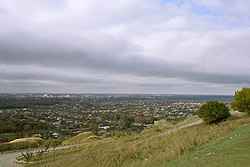Novokubansky District
 From Wikipedia the free encyclopedia
From Wikipedia the free encyclopedia
Novokubansky District Новокубанский район | |
|---|---|
 View of Armavir, in Novokubansky District | |
 Location of Novokubansky District in Krasnodar Krai | |
| Coordinates: 45°06′11″N 41°02′52″E / 45.10306°N 41.04778°E | |
| Country | Russia |
| Federal subject | Krasnodar Krai[1] |
| Established | 1936 |
| Administrative center | Novokubansk[1] |
| Area | |
| • Total | 1,823 km2 (704 sq mi) |
| Population | |
| • Total | 86,311 |
| • Estimate (2018)[3] | 86,967 (+0.8%) |
| • Density | 47/km2 (120/sq mi) |
| • Urban | 40.4% |
| • Rural | 59.6% |
| Administrative structure | |
| • Administrative divisions | 1 Towns, 8 Rural okrugs |
| • Inhabited localities[1] | 1 cities/towns, 52 rural localities |
| Municipal structure | |
| • Municipally incorporated as | Novokubansky Municipal District[4] |
| • Municipal divisions[4] | 1 urban settlements, 8 rural settlements |
| Time zone | UTC+3 (MSK |
| OKTMO ID | 03634000 |
| Website | http://novokubanskiy.ru/ |
Novokubansky District (Russian: Новокуба́нский райо́н) is an administrative district (raion), one of the thirty-eight in Krasnodar Krai, Russia.[1] As a municipal division, it is incorporated as Novokubansky Municipal District.[4] It is located in the east of the krai. The area of the district is 1,823 square kilometers (704 sq mi).[citation needed] Its administrative center is the town of Novokubansk.[1] Population: 86,311 (2010 Russian census);[2] 87,478 (2002 Census);[6] 76,275 (1989 Soviet census).[7] The population of Novokubansk accounts for 40.4% of the district's total population.[2]
Geography[edit]
The Kuban River flows through the district.
Climate[edit]
The district is vulnerable to extended drought conditions. Average annual precipitation is 551 millimeters (21.7 in).
Economy[edit]
The district has very fertile soil, so the agriculture and food industry are developed. Farmlands cover 1,370 square kilometers (530 sq mi), or 75% of the district's territory.
Transportation[edit]
Major federal roads and railway pass through the district, playing a substantial role in its economy and life of local communities.
References[edit]
Notes[edit]
- ^ a b c d e Reference Information #34.01-707/13-03
- ^ a b c Russian Federal State Statistics Service (2011). Всероссийская перепись населения 2010 года. Том 1 [2010 All-Russian Population Census, vol. 1]. Всероссийская перепись населения 2010 года [2010 All-Russia Population Census] (in Russian). Federal State Statistics Service.
- ^ "26. Численность постоянного населения Российской Федерации по муниципальным образованиям на 1 января 2018 года". Federal State Statistics Service. Retrieved January 23, 2019.
- ^ a b c Law #1233-KZ
- ^ "Об исчислении времени". Официальный интернет-портал правовой информации (in Russian). June 3, 2011. Retrieved January 19, 2019.
- ^ Federal State Statistics Service (May 21, 2004). Численность населения России, субъектов Российской Федерации в составе федеральных округов, районов, городских поселений, сельских населённых пунктов – районных центров и сельских населённых пунктов с населением 3 тысячи и более человек [Population of Russia, Its Federal Districts, Federal Subjects, Districts, Urban Localities, Rural Localities—Administrative Centers, and Rural Localities with Population of Over 3,000] (XLS). Всероссийская перепись населения 2002 года [All-Russia Population Census of 2002] (in Russian).
- ^ Всесоюзная перепись населения 1989 г. Численность наличного населения союзных и автономных республик, автономных областей и округов, краёв, областей, районов, городских поселений и сёл-райцентров [All Union Population Census of 1989: Present Population of Union and Autonomous Republics, Autonomous Oblasts and Okrugs, Krais, Oblasts, Districts, Urban Settlements, and Villages Serving as District Administrative Centers]. Всесоюзная перепись населения 1989 года [All-Union Population Census of 1989] (in Russian). Институт демографии Национального исследовательского университета: Высшая школа экономики [Institute of Demography at the National Research University: Higher School of Economics]. 1989 – via Demoscope Weekly.
Sources[edit]
- Управление по взаимодействию с органами местного самоуправления Администрации Краснодарского края. Справочная информация №34.01-707/13-03 от 23 мая 2013 г. «Реестр административно-территориальных единиц Краснодарского края». (Department of Cooperation with the Organs of the Local Self-Government of the Administration of Krasnodar Krai. Reference Information #34.01-707/13-03 of May 23, 2013 Registry of the Administrative-Territorial Units of Krasnodar Krai. ).
- Законодательное Собрание Краснодарского края. Закон №1233-КЗ от 4 мая 2007 г. «Об установлении границ муниципального образования Новокубанский район, наделении его статусом муниципального района, образовании в его составе муниципальных образований — городского и сельских поселений — и установлении их границ», в ред. Закона №1756-КЗ от 3 июня 2009 г «О внесении изменений в некоторые законодательные акты Краснодарского края об установлении границ муниципальных образований». Вступил в силу со дня официального опубликования. Опубликован: "Информационный бюллетень ЗС Краснодарского края", №53 (I), 21 мая 2007 г. (Legislative Assembly of Krasnodar Krai. Law #1233-KZ of May 4, 2007 On the Establishment of the Borders of the Municipal Formation of Novokubansky District, on Granting It the Status of a Municipal District, on the Establishment of the Municipal Formations—Urban and Rural Settlements—Within Its Structure and on the Establishment of Their Borders, as amended by the Law #1756-KZ of June 3, 2009 On Amending Several Legislative Acts of Krasnodar Krai on the Establishment of the Borders of the Municipal Formations. Effective as of the day of the official publication.).

